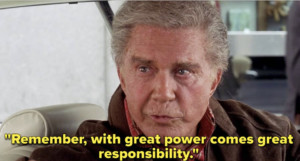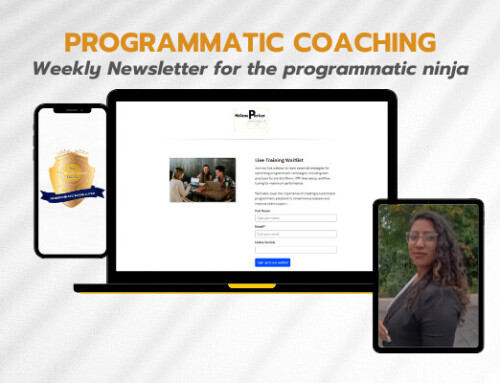Case Study: How I Trained A team of 5 Creatives In CM360

I’ve been receiving a few private messages asking about Ad trafficking best practices, and it made me think of sharing a success story from one of my agency clients. They are a multi-six-figure agency offering full marketing and advertising services to their national and global brands. My goal was to provide programmatic media support to the team as the agency-client was experiencing rapid and steady growth from current and new clients.
With Growth comes power and with power comes great responsibility.
Similarly to most agency clients I’ve worked with post-pandemic, they experienced the following challenges during their growth:
- Understaffed in several positions
- Lack of expertise in programmatic media (why they contracted my services)
- Human errors led by overworked team members and unrealistic deadline
- Operating under a “get this in and active as soon as possible” mindset
With my experience working and building programmatic media departments for startup agencies, I offered several recommendations to address and help implement tools that made the team efficient.
Let me set the stage:
The programmatic media team of 2 was submerged by request and demanded to get things “live and spending” within a fair timeline. They used Campaign Manager 360 (CM360) as an ad server and Display and Video 360 (DV360) as the demand-side platform (DSP).
This is absolutely normal, but my agency client was scaling and growing and struggling to hire additional help. (Aren’t we all?)
The team’s struggle was apparent.
There were some unfortunate human errors. If you know anything about Ad operation and trafficking in CM360, you can agree that things are especially complex and repetitive.
Running the incorrect ads, omitting to turn ON ads or placements, tags sent to the wrong vendor, etc.
These are all avoidable mistakes with the right systems and tools in place, and this is what and how we addressed it.
How to empower teamwork and encourage cross-departmental support?
I took an assessment of the internal workflow and realized we could “outsource” the tasks that took the longest:
✅ Uploading and assigning creatives to their respective Ads and placements within CM360
We kept it straightforward and simple.
This may come across as so simple, but it is important and extremely time-consuming. It requires patience and consistency (and can often lead to wine before 5 P.M.). It is easy to assign incorrectly, and let’s be real, most of our agency friends do not have 3-4 weeks to spare in the launch process. We got to get it in and live A.S.A.P, right?
They suggested taping into their creative team, considering they were project-based and sometimes in-between projects allowing flexibility.
Yes, I trained a team of 4 individuals with no programmatic media background on how to traffic ads in CM360 successfully and swiftly in less than a month. The training took a couple of hourly sessions and, of course, reinforcement training sessions as they completed the first couple of requests.
Here’s the secret sauce:
I spent just enough time outlining and streamlining the process to execute task by task using training documents, refer to any training videos completed, and have access to my expertise.
To implement this, you will need the following:
- Walk-through of CM360 (or the adserver you use) of the task only: during this time, we simply walk through the platform and record step by step of the one task.
- Written documentation (think of this like an SOP) of the walk-through: The written version of the visual walk-through mentioned above.
- Utilization of trafficking sheet or Tsheet: if you are not familiar, a Tsheet is an excel doc where important details about the campaigns and creatives are included. I’ve created a high-level one here, but I’m happy to offer recommendations on implementing Tsheets.
- Time to implement this process internally: it took us about a month to implement and for the team to become self-sufficient. It could’ve taken less, but we had to be mindful of the creative team’s priorities. We also allowed testing in the platform for each team ninjas to get them comfortable with the engine.
- Post-set-up and pre-launch QA checklist: these checklists were truly life-saving for the team, and even additional team members, not creative, volunteered to help with this final process before the campaigns were activated.
- Courage and Patience to follow through the winning steps above: Change is hard and scary. We framed this as an exciting opportunity to learn a new skill and encourage servant leadership. The programmatic lead was beyond grateful. It is a win-win for the team!
In conclusion:
The old process was the programmatic ninja completing all the trafficking, QAing, and setting up of campaigns in DSP, taking them a lot of time to launch. The new process was reduced to 5-7 business days by encouraging teamwork and implementing a clear, detailed training process. All of it was recorded so that the agency client could continue replicating this process with new hires.
The creative team can now upload creatives to the correct advertiser and campaign in CM360, assign creatives to the right ads, and create new ones if necessary. They can also assign the correct CTL (Click-Through Links) to each individual creative.
Here’s something the agency leaders did that makes it even more impressive: They rewarded and incentivized the team that volunteered. They allowed that said team to try and learn new skills while respecting their responsibility and always showing appreciation. A temporary solution turned into well-received promotions while more help was hired and trained.
This was one of many ways I helped past agency and brand clients. It is part of the programmatic media solution service I offer. How can we look at your internal operation and complement each team player in a non-toxic environment?
You are one email or phone call away from being another success story!





